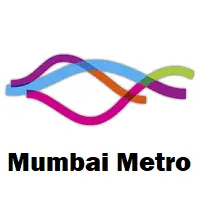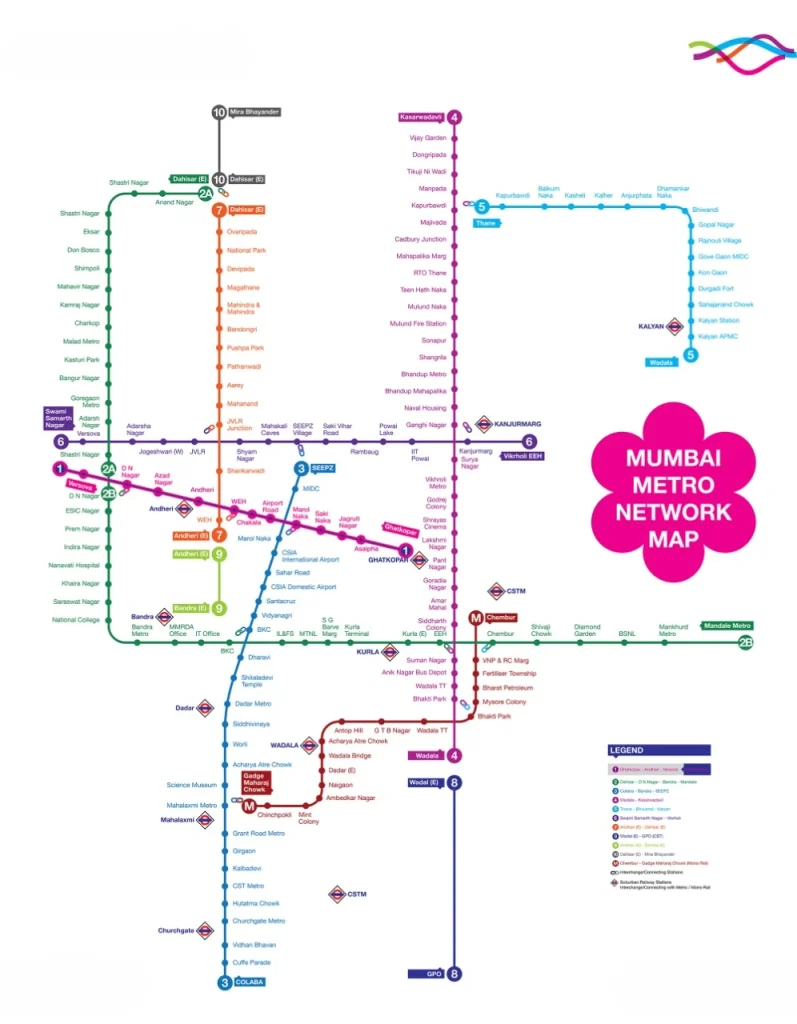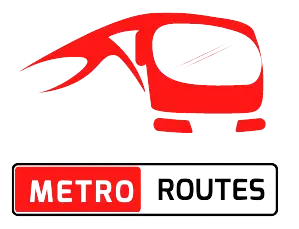Mumbai Metro

Mumbai Metro
MMRCBrief History
In June 2006, Prime Minister Manmohan Singh laid the foundation stone for the first phase of the Mumbai Metro project and the Mumbai Metro One Private Limited (MMOPL) was formed, although the construction work began in 2008. The first phase of the Mumbai Metro was inaugurated on 8 June 2014, and since then, it has become a vital mode of transportation for millions of commuters. Mumbai Metro is the sixth longest operational metro network in India with an operational length of 46.4 km (28.8 mi) as of January 2023.
Mumbai Metro Operational Lines
Currently, there are only three operational lines in the Mumbai Metro system – Line 1, Line 2A and Line 7.
Metro Line 1 or Blue Line
Line 1 or Blue Line, also known as the Versova-Andheri-Ghatkopar (VAG) line, spans a distance of 11.4 kilometers (7.08 mi) and connects Versova in the west to Ghatkopar in the east. It has 12 stations and is fully elevated and is well known for its air-conditioned coaches and spacious interiors.
Metro Line 2A or Yellow Line
Line 2A or Yellow Line, also known as the Dahisar-Andheri-West (DAW) line is 18.6 kilometers (11.551 mi) long and connects Dahisar in the north to Mankhurd in the east. It has 17 stations and is equipped with modern amenities such as Wi-Fi, CCTV cameras, and automatic fare collection.
Metro Line 7 or Red Line
Line 7 or Red Line runs from (Dahisar East – Gundavali), it has a total length of 16.5 Km (10.25 mi) and 14 operational stations. Its construction started in 2016 and completed in Jan 2023. It is operated by Maha Mumbai Metro Operation Corporation Ltd.
Mumbai Metro Under-Construction Lines
Metro Line 2B or Yellow Line
Line 2B or Yellow Line, is the under construction phase. Its route from DN Nagar to Mandale spans 23.64 kilometers (14.69 mi) long. It has 20 stations and is equipped with modern amenities such as Wi-Fi, CCTV cameras, and automatic fare collection. It is further divided into 4 packages – ESIC Nagar to Khira Nagar, Saraswat Nagar to ILFS, MTNL Metro to Chembur, and Diamond Garden to Mandale.
Metro Line 3 or Aqua Line
Line 3 or Aqua Line, also known as the Colaba-Bandra-SEEPZ, is a 33.5 Km 20.8 mi) long line and consists of 27 stations where 26 stations will be underground and 1 station at grade. This line will be Mumbai’s first completely underground metro line , linking Cuffe Parade in the south to Kanjumarg in the north.
It is delayed due to various reasons and expected to complete the first phase of the Metro corridor on Bandra-SEEPZ by January 2024, and remaining corridor 2025 according to The Mumbai Metro Rail Corporation Limited (MMRCL).
Metro Line 4 or Green Line
Line 4 or Green Line, also known as (Wadala – Kasaravadavali) is a fully elevated corridor, which spans over 32.32 kilometers (20.08 mi) and consists of 32 stations. It connects the densely populated areas of Mumbai, including Wadala, Ghatkopar, Mulund, and Kasarvadavali. This line also provides seamless connectivity to other modes of transportation such as local trains, buses, and taxis.
Metro Line 4A or Green Line
Line 4A or Green Line is a proposed extension of the Mumbai Metro Line 4, which connects Wadala in Central Mumbai to Kasarvadavali in Thane district. The proposed length of the line is approximately 2.78 kilometers (1.72 mi) and it will have two stations – Gaimukh and Shivaji Chowk. The line is expected to be completed by Dec 2025 and will significantly reduce travel time for commuters in the region.
Metro Line 5 or Orange Line
Line 5 or Orange Line, commonly known as the Thane-Bhiwandi-Kalyan Metro, is a metro system in Mumbai that connects the suburbs of Thane, Bhiwandi, and Kalyan. It is 24.9 km (24.9 mi) long and the first metro line in the Mumbai Metropolitan Region (MMR) to link these three cities. The line will consist of 17 stations, with two interchange stations located at Kapurbawdi in Thane and Kalyan.
Metro Line 6 or Pink Line
Line 6 or Pink Line, also known as (Swami Samarth Nagar – KanjurMarg – Vikhroli) is a proposed 14.47 km (8.99 mi) long elevated corridor, which will connect the suburbs of Lokhandwala-Jogeshwari-Vikhroli in Mumbai. Pink Line will include 13 stations, and have been designed to meet the demands of the passengers and ensure their safety and comfort while traveling.
Metro Line 7A or Red Line
Line 7A or Red Line, also known as (Andheri East – CSIA Terminal 2) metro corridor is 3.17 Km (1.96 mi) long, of which Elevated is (0.98 km) & Underground is (2.915 km) long. The metro route has 2 stations from Andheri East – CSIA Terminal 2.
The Metro Line 7A is an extended addition to Line 7. The metro route was supposed to run between Dahisar and Andheri, but the state government eventually decided to expand it.
Metro Line 9 or Red Line
Line 9 or Red Line, also known as (Dahisar East – Mira Bhayandar) is a proposed line covering a distance of 11.38 km (7.0712042 mi) and its completion is scheduled by 2025. The line will have 7 stations, Metro corridor 9 is an extension of the Metro line 7 plan. The metro route, which was planned to run between Dahisar and Andheri, was finally decided to be extended by the state government.
Mumbai Metro Approved Lines
Metro Line 8 or Gold Line
Line 8 or Gold Line, is an Airport Express Line part of the metro system for the city of Mumbai & Navi Mumbai.The metro line will connect the two Airports, i.e. Chhatrapati Shivaji International Airport (CSIA) with the proposed Navi Mumbai International Airport (NMIA). The 40 km (25 mi) line is fully elevated. Eight metro stations have been proposed on this line with a frequency of 15 minutes.
Metro Line 10 or Green Line
Line 10 or Green Line (extension), commonly known as Gaimukh-Shivaji Chowk (Mira Road) corridor, is a proposed line having distance of 9.2 km (5.7 mi) from Gaimukh to Shivaji Chowk (Mira Road) Metro-10. It has 4 stations and is fully elevated line. It is expected to be completed in 2024.
Metro Line 11 or Green Line
Line 11 or Green Line (extension), also known as Wadala–CSMT is a part of the Mumbai metro system. Line 11 stretches 14 km (8.7 mi) and a total of 10 stations have been planned on this extension. Out of which 8 are Underground and 2 are Elevated. Passengers from Mumbai’s eastern port region can use the stations. The average inter-station distance is 1.27 km (0.79 miles), however it can range from 0.85 km (0.53 miles) to 2.1 km (1.3 miles) depending on the location, operational requirements, and traffic conditions.
Metro Line 12 or Orange Line
Line 12 or Orange Line (Extension), also known as Kalyan-Dombivli-Taloja Line is a planned line of Mumbai Metro. The line will be 20.75 km (12.89 mi) in length and will be entirely elevated. There will be 18 stations. This line will link Kalyan-Dombivali and Navi Mumbai cities. Line-12 is the extension of already under construction Line-5 (Thane – Bhiwandi – Kalyan). MMRDA approved the Kalyan-Dombivli-Taloja Metro line.
Metro Line 13 or Purple Line
Line 13 or Purple Line, It is a proposed metro project to connect Mira Road with Virar. The project length is 23 km. This line will be operational by October 2026.
Metro Line 14 or Magenta Line
Line 14 or Magenta Line is an approved metro project to connect Vikhroli with Kanjurmarg and further to Ambernath-Badlapur. It will have an intersection at Kanjurmarg with Line 6, the Pink Line. The project length is 45 km (28 mi) and it will be completed by October 2026.
Mumbai Metro Quick Info
| Operational Lines | Line 1, Line 2A and Line 7 |
| Total Stations | 43 |
| Total Length | 46.5 Km (28.89 mi) |
| Average Daily Ridership | 500,000 (approx.) |
| Operator | Mumbai Metro One Private Limited (MMOPL) Maha Mumbai Metro Operation Corporation Ltd (MMCL) |
| Timings | Start | Close 5:55 AM | 09:24 PM |
| No of Coaches | 04 Nos. |
Mumbai Metro Fare
The Mumbai Metro follows a distance-based fare system, with fares ranging from Rs. 10 to Rs. 60, depending on the distance traveled. The minimum fare for a single journey on the Mumbai Metro is Rs. 10, while the maximum fare is Rs. 60. Commuters can purchase tickets from ticket vending machines installed at every station, or they can opt for a smart card, which provides discounts on fares and can be recharged online.
FAQs
Q. What are the operating hours of the Mumbai Metro?
A. The Mumbai Metro operates from 5:55 AM to 09:24 PM midnight, with a frequency of approximately 4 minutes during peak hours and 8 minutes during non-peak hours.
Q. Is the Mumbai Metro safe for women commuters?
A. Yes, the Mumbai Metro is a safe and secure mode of transportation for women commuters. The coaches are equipped with CCTV cameras, and there is a separate women-only coach in every train.
Q. Can luggage be carried on the Mumbai Metro?
A. Yes, luggage can be carried on Mumbai Metro.
Advantages
- One of the biggest advantages of the Mumbai Metro system is that it saves time. The trains run at regular intervals, and passengers can reach their destinations quickly.
- The Mumbai Metro system is cost-effective rather than other sources of transportation. The passengers can travel a long distance at a low cost.
- The Mumbai Metro trains are air-conditioned and comfortable. Also providing cushioned seats with large size windows, giving a good view of the city.
- The Mumbai Metro system is environmentally friendly as it reduces air pollution and congestion on the roads.
- The Mumbai Metro system is safe and secure for passengers. The stations and trains are equipped and monitored by CCTV cameras.
Disadvantages
- Overcrowding is one of the bigger disadvantages among others of the Mumbai Metro system. Trains are crowded during rush hours, making it hard for passengers to get on and get off them.
- The Mumbai Metro system has a limited area of coverage and lacks access to all areas of the city, causing it useless for people who reside or work in those areas.
- The Mumbai Metro system requires regular maintenance, and disruptions to service can occur during maintenance work. Which can be ineffective for the passengers using the system for their daily commute.
- The Mumbai Metro system is not easily accessible for physically disabled people. Many stations are without lifts or ramps, which makes it difficult for wheelchair users and disabled people.
- The Mumbai Metro system has limited hours of operation. The trains do not run in late night hours, making it inconvenient for late night workers or who need to travel at night.
Conclusion
Mumbai Metro provides quick and economical travel for its residents, but it also has availability and coverage issues. Despite limitations, the Mumbai Metro system is still an essential part of the city’s transport system and continues to meet the needs of Mumbai residents. The Mumbai Metro system has the ability to become a better and more feasible form of transportation for the city’s residents.
Mumbai Metro Map

